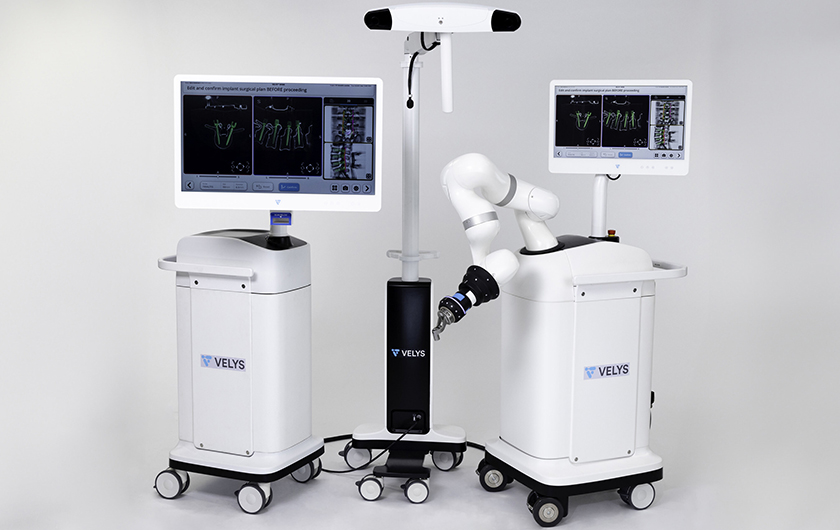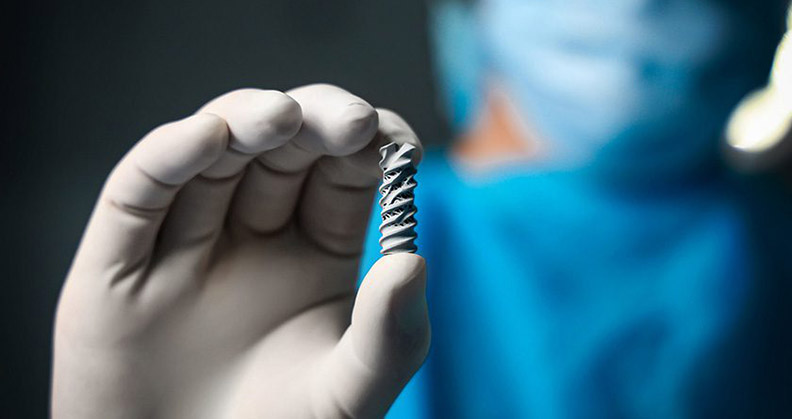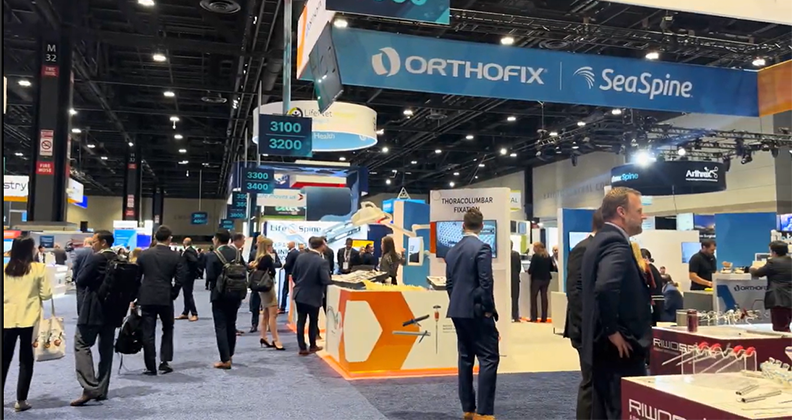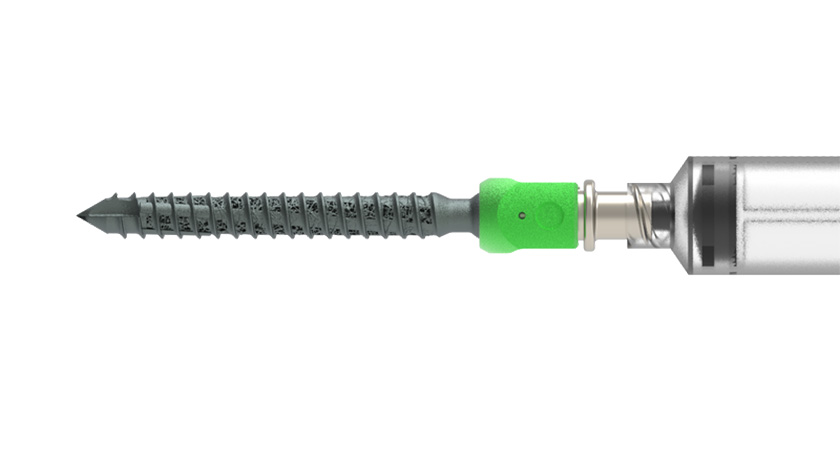
In 2020, Johnson & Johnson MedTech set out to create something entirely new in the world of robotic spine surgery. Unlike past collaborations in which companies built on existing platforms, this project involved a build-to-buy partnership with eCential Robotics that signals the future of medtech innovation.
J&J MedTech partnered with France-based eCential Robotics to develop the VELYS Active Robotic-Assisted System, which received FDA 510(k) clearance in August 2024. The dual-use system features both standalone navigation and an active robotics platform to help surgeons perform complex spinal fusion procedures in the cervical, thoracolumbar and sacroiliac spine.
“We began with a blank slate,” said T.J. Minogue, Senior Marketing Manager of Global Robotics and Enabling Tech at J&J MedTech. “This was one of the earliest examples of a build-to-buy strategy, which required an incredible amount of resources and capital from both companies.”
Trust that the project was worth investing in was critical, especially early on. “Both sides took on risk,” Minogue said. “We were building something entirely new. But we had a prior relationship with the eCential team, and that familiarity helped move us forward.”
The cross-industry collaboration and unique supplier build-to-buy business model has paved the way for faster innovation by larger strategics and earned J&J MedTech the 2025 OMTEC Award for Next-Gen Innovator. The company will be honored during an award ceremony before OMTEC’s Keynote Breakfast on Wednesday morning, June 18. Later in the day, representatives from the winning companies will share lessons learned and actionable advice at an engaging panel discussion,
With the success of the VELYS Spine platform, J&J MedTech’s design and commercialization approach serves as a blueprint for how industry approaches collaborative design moving forward, resulting in faster time-to-market initiatives and innovation cycles.
Virtual Beginnings
The contract with eCential was signed in early 2020. Within months, COVID shut down global travel. “The company is based in France, and for the first year and a half, we couldn’t get on a plane to collaborate in person,” Minogue said.
That forced a new kind of digital-first design process among the project’s engineers and surgeon consultants. “We conducted walkthroughs over Zoom,” Minogue said. “A team member would use their iPhone camera to show the system’s design. It was crude, but it worked. And it taught us about the critical importance of nailing the communication piece and over-communicating throughout the entire project.”
Despite the challenges, or perhaps because of them, the two companies forged a stronger working relationship and baked numerous touchpoints into the project’s timeline. That level of diligence became a habit, and it paid off.
Some of the project’s biggest technical breakthroughs came directly from the collaboration between design and engineering teams based in France and the U.S. One example: a feature called “screw release mode.”
During the VELYS development process, engineers identified a flaw that exists in current robotic spine platforms. The issue stems from built-up pressure that occurs when the robot is rigidly maintaining alignment to a position, while the multi-axial pedicle screw that’s being delivered needs to adjust to the patient’s anatomy.
Forces begin to build when a rigid robotic system holds the screwdriver steady as the screw head moves. This pressure makes it difficult to unthread the screwdriver from the screw head after implantation. If surgeons can detach it, the sudden release of tension could cause the robotic arm to shudder. In some cases, surgeons can’t remove the screwdriver, forcing them to disassemble the distal end of the robotic arm to retrieve the instrument, which disrupts workflow significantly.
To solve this issue, J&J MedTech’s mechanical engineers worked hand in hand with eCential’s software team. VELYS Spine understands the screw’s position relative to the anatomy and automatically allows for a smooth, seamless screw release. That feature became one of the VELYS system’s key differentiators.
Another key innovation focused on the design of the graphical user interface. J&J MedTech’s Industrial Design and Human Factors group helped eCential completely rethink the user interface by streamlining the presentation and simplifying icons. They even rethought button placement and color schemes to leverage click efficiency. The interface has been described as “Fisher Price-looking.”
“That was by design,” Minogue said. “It’s intuitive and easy to use. The feedback from surgeons has been overwhelmingly positive.”
VELYS Spine wasn’t just built to be functional. It was built around the needs of surgeons.
“Most robots are designed to improve precision, reduce blood loss or enhance screw placement,” said Mike Kuhn, Director of Global Marketing at J&J MedTech. “Those are important factors, but we wanted to go a step further and design a system that reduces the cognitive load on the surgeon.”
That idea became the foundation for the project’s cognitive load analysis. “We’re now running a major study on how the system impacts surgeon decision-making, focus and longevity,” Kuhn said. “We’re not just looking at physical fatigue or accuracy. We’re looking at how this system can help surgeons stay mentally sharp through long, complex cases.”
Those efforts brought a human performance lens to the project. “How can we improve surgeon interaction with technology?” Minogue asked. “We wanted to build a system around the surgeon so that it’s least disruptive to their existing workflows. That reduces errors and improves patient outcomes.”
J&J MedTech’s collaboration with eCential wasn’t about building the flashiest robot. “We weren’t trying to add more bells and whistles,” Kuhn said. “We designed a system that’s easy to use, forgiving and flexible.”
Important Lessons Learned
With VELYS Spine now FDA cleared and moving toward broader commercial rollout, the J&J MedTech team is reflecting on what they learned during the development project, and how it might shape the next generation of surgical robotics.
“We could have tried to build VELYS internally, but working with a company that already had deep robotic expertise helped us move much faster,” said Shelby Cook, Integration Lead at J&J MedTech.
The partnership also helped manage costs and maximize resources. “Even at J&J, we have finite resources,” Cook said. “Choosing what to build internally and what to co-develop externally allowed us to allocate our budget more strategically.”
And then there’s the broader shift toward digital surgery. “Medicine has always lagged behind other industries in adopting digital tools,” Minogue said. “But we’re starting to catch up. With better data collection and smarter systems, we can accelerate a surgeon’s learning curve.”
Rather than relying purely on personal experience, tomorrow’s surgeons will benefit from intelligent systems that guide decision-making, document outcomes and identify patterns. “It’s the digitization of surgical practice,” Minogue added. “We’re helping surgeons mature faster, learn faster and raise the standard of care. That’s what the North Star should be.”
The VELYS Spine Active Robotic System is more than a technical achievement. It’s a statement about what’s possible when companies collaborate across disciplines and borders — and even pandemics.
With a growing install base, the J&J MedTech team is already thinking ahead. But at the core, the mission remains the same. “We’re here to improve patient outcomes,” Minogue said, “and digital surgery will accelerate that pathway.”
DC
Dan Cook is a Senior Editor at ORTHOWORLD. He develops content focused on important industry trends, top thought leaders and innovative technologies.




